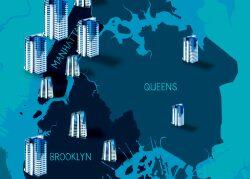The Adams administration this week floated several ideas to allow more housing development.
Possibilities discussed by the Department of City Planning at an online session included allowing more housing density in low-density commercial districts and removing minimum requirements for apartment sizes to permit “no-frills studios,” according to Crain’s.
“We know that a lot of people in New York City want to live alone but can’t,” said the agency’s John Mangin, the publication reported. “We force a lot of these folks … to find roommates and take family-sized apartments in neighborhoods around the city. Or we force them into even worse situations.”
He was referring to the city’s building codes and zoning, but the City Council, which controls land use in the five boroughs, has contributed to the shortage of smaller units. When developers request rezonings for residential projects, the local Council member often requires them to remove studios and one-bedroom apartments from the plans and replace them with larger units, figuring that families will move in.
Julie Won of Queens recently laid out terms developers must meet to gain her approval for rezoning, one of which was to “prioritize two- and three-bedroom apartments that accommodate families,” Sunnyside Post reported.
The result is fewer units than proposed — and roommates with two, three or four incomes outbidding families for the housing.
Read more



The idea of converting hotels to apartments was also broached by City Planning. Zoning prevents some former hotels from being converted into multifamily buildings, and supportive housing requirements can be even stricter.
Minimum size requirements for apartments could be changed to allow some hotels to be converted without gut renovations, Mangin said.
Another issue is that light and air requirements are much greater for residences than for commercial buildings. Notably, every bedroom must have a window. That makes it difficult and expensive to turn an office building with large floor plates into a rental with a lot of apartments. For example, it can require removing the middle of the building to create a shaft for light to reach the interior.
Liberalization of light and air rules could make it easier to convert the city’s many aging, Class B and Class C office buildings into housing, significantly raising their value, which has dropped in the work-from-home era.
Also discussed was allowing single-story churches to build more housing above their structures. Projects above churches can already add more units — that is, get a bump in floor-area ratio — if they offer affordable senior housing. City Planning proposed expanding that incentive to all types of affordable housing.
The planning agency also proposed relaxing minimum parking requirements to incentivize larger developments. Outdated parking mandates compel builders to include more garage space than they want to, diverting a chunk of project budgets to a non-housing use and forcing developers to forgo more attractive amenities.
Housing in New York City has been even tougher to come by since people started returning after the height of the pandemic. Residential brokerages saw record breaking numbers in 2021 and rents hit record highs this summer.
Things aren’t any better outside of the city. The entire country is grappling with a housing deficit: An estimate by Realtor.com earlier this year found the country is short by 5 million homes.
